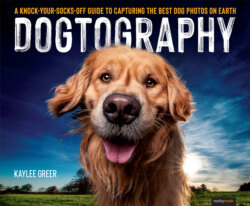Читать книгу Dogtography - Kaylee Greer - Страница 17
На сайте Литреса книга снята с продажи.
Positive Reinforcement
ОглавлениеOh, positive reinforcement, what would I do without you? Without writing a full-length dissertation on the subject, let me sum up the concept of positive reinforcement in the simplest way possible: instead of punishing a dog for bad behavior, you reward him for good behavior. Sounds simple, right? In truth, it kind of is.
Undoubtedly, I will use positive reinforcement at every single one of my shoots. For this example, let’s recruit our old pal Hank the chocolate lab, again.
I’ve made my introduction to Hank, and I can tell he thinks I’m one of the good guys. We’re off to a great start, but the second I take out my camera, with it’s black, clicking body, and it’s long 70-200mm lens, I can tell that Hank doesn’t trust it. Perhaps he thinks my bizarre contraption is a relative to the dreaded vacuum cleaner he does battle with every week at home. Perhaps it reminds him of a snake that once bit him when he was a pup. Who knows? The bummer is, I can’t explain to Hank what the purpose of this odd clicking box is. I have to find another way to let him know that this new and strange item will not hurt him. Even better, how about letting him know that it will benefit him—maybe even bring him treasures! I want him to associate this bizarre camera machine with his favorite stuff in the world (perhaps treats, a favorite toy, or even a good old-fashioned neck scratch). Here’s exactly how I make that association.
Let’s say that Hank loves treats. (A Chocolate Lab who loves treats?? Blasphemy!) First, I’ll place my camera on the ground maybe five feet away from Hank. Hank gets a treat. Then, I’ll coax Hank a foot closer to the camera. Hank gets another treat. Closer, treat, closer, treat. So far, so good.
Once Hank is confident enough to be close to the camera, I’ll actually put a treat directly on my camera body or lens and allow Hank to eat directly off of the strange device.
Will your camera get covered in dog slobber? Yes. (And the guy that you take your camera to once every few months to have it cleaned will invariably say, “What did you do to this thing?!”) But that’s the name of the game.
Next, I’ll pick up the camera. Hank gets a treat. Then I’ll click the shutter. Hank gets yet another treat. With enough repetition Hank will make the connection that every time my camera makes a clicking sound, a treat is coming. (And if you know anything about Chocolate Labs, you know they don’t want to live in any other reality than the one in which another treat is coming.) This method of positive reinforcement is simple, easy, incredibly effective, and should be used throughout the entire shoot. If you come across a dog who is not treat motivated, try a toss of a favorite ball or toy as a reward. If your dog is neither treat nor toy motivated, use the owner to positively reinforce the behavior with a “good boy” and a scratch behind the ear. Use whatever motivator your particular dog model might value the most as a frequent reward, and you’ll be set up to capture him giving his best, happiest expressions while looking directly into your camera. Pure gold.
